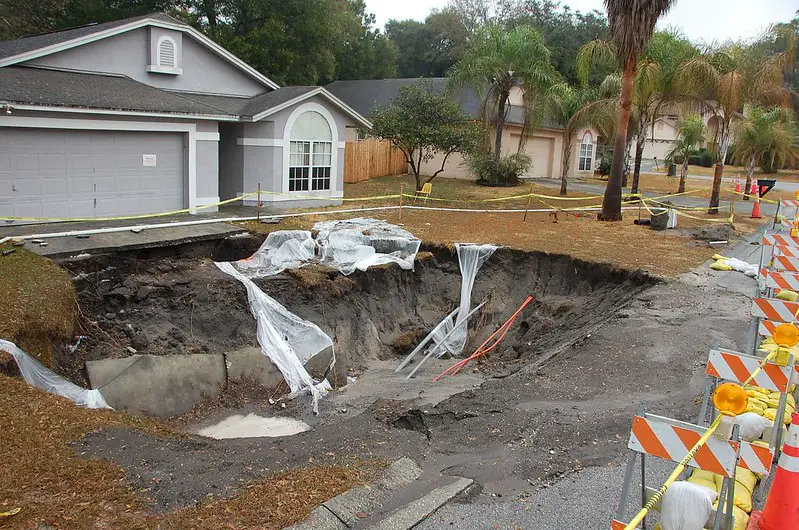A sinkhole is a hole in the ground left when water has eroded the surface of soil and bedrock. Most often, a sinkhole begins with slowly dissolving bedrock, which may have been slowly pulverized by the action of running water. This often occurs when you have a water leak in your garden.
Sinkholes occur all over the world. They vary in size from small undeveloped potholes to massive caves hundreds of feet deep that can span across hundreds of acres, but they’re all caused by underground water moving through cracks in the bedrock or from erosion. Here are some ways to avoid sinking into a sinkhole today.
[ez-toc]
Causes of a sinkhole in a yard
Sinkholes are caused by a variety of factors, including:
– A leaking drain or pipe that has piled up water. The water supply is under a lot of pressure and a leak can cause the ground to get saturated and collapse. This can happen quite fast and therefore it is important that you keep an eye out for water leaks.
-A badly drained field that accumulates water over time. Drainage can spread the water out over a bigger area.
– The erosion of bedrock, which causes the soluble rock, like limestone or gypsum to dissolve from below.
– A natural sinkhole in karst terrain that has formed over millennia.

Sinkholes vary in size, depth, and severity. Sometimes they can result in a crack in your wall, a fence that is falling over, or a hole in your garden.
How to fix a sinkhole
The first step is to find the cause of the issue. Is it a leaking drain, a badly drained field or is there an issue with the composition of the soil? Different people might have to study this, from plumbers to seismologists and geologists. Once the problem has been identified, it can be fixed. It is only after this step that you can fill in the hole. Most people just fill the hole and hope for the best. This could result in further damage so you have to be careful when you pick this option.
Small sinkholes can often be filled in with clay or sand. This is then finished by adding topsoil over it. If they were caused by a leak in your drain, it might be needed to fix this as well. A plumber can run a camera in your system or use a pressure test to see if your system holds water. Standing water can erode the ground and create holes in your garden. You should consult with a local expert. They can examine the composition of your ground and offer advice. You will need professional help if this happens inside your house.
Larger sinkholes require more work. In some instances, poles have to be installed in the ground to stabilize it. This makes sure that the ground doesn’t shift again. Once this is done, several layers of clay and soil are bein added so that the underground is stable enough. This has to be done by a professional firm and studies have to be conducted to make sure that it happens correctly. You can’t DIY yourself out of this problem.
Ways to prevent a sinkhole
Here are some ways to avoid sinking into a sinkhole today:
–Don’t build anything on top of an unstable foundation
-Get proper drainage and make sure your property is inspected
-Contact a seismologist if you have questions about potential sinkholes
Fixing a sinkhole is expensive, as the cost of the excavation and repair can be high given the amount of work that is involved.
To avoid sinking into a sinkhole, it’s best to pay attention to the surrounding area and stay away from any cracks in the ground. If you see that the ground is unstable, walk around it. Look for broken pavement or loose gravel. If there are any nearby cracks in the ground, take note of their location and head in a different direction.
A plumber has specialized equipment to find holes in your plumbing system. It can still take some time to find it though. Not every plumber has this so you will have to inquire when you call one.
If you believe that you’ve already experienced some sinkhole-related issues, make sure to report them to your local municipality so that they can help prevent these types of accidents from happening again. Studies will be needed to see what is going on.
The dangers of sinkholes
Sinkholes are usually caused by water, but they can also be caused by rain, wind, earthquakes, or mining.
Although the sinkhole may not seem dangerous while it’s forming, it can become perilous when they’re full of water. Sinkholes are often very deep and have been known to swallow up people and animals. They can also collapse after heavy rain and cause significant damage to buildings in the area.
Do sinkholes occur often?
Sinkholes do occur frequently. There are an estimated 25,000 sinkholes in the United States and there is a sinkhole on average every day. The number of incidents increases with the size of the sinkhole, but because most of these incidents are small, most people will never even notice them.
Does insurance cover sink holes?
Yes, most insurance policies cover sinkhole damage. It’s important to check your policy for coverage before you dig up your backyard, but if you find it does not provide any coverage, contact your insurance provider and see if they can help. Some policies might require that you have reports that prove that you have built-in stable ground.
To conclude, we can state that sinkholes are serious matters. The root cause has to be found (from a water leak to the composition of the ground). Once this has been done, the hole can be filled based on the required components that have been outlined by a geologist.
